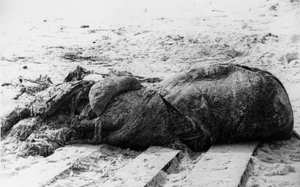People have always been interested in things that are strange, unexplained, or paranormal. No television show better exemplified that driving passion than “The X-Files.” Somehow they made us belief in the unbelievable and that somewhere out there the truth really did exist. Say the names Loch Ness, Big Foot, or Chupacabra and most people recognize the names. However, they are far from the most unusual sightings that have been experienced. There are hundreds more with which we are far less familiar. Most of the time, these creatures are lumped together under the broad categorical term of “globsters.” The name identifies a series of unusual and unidentified creatures that have often been found beached in the sand or pulled from the water around the world.
Some claim that these sea creatures are nothing more than deformed whales, sharks, squids or other types of sea life. However, others believe them to be the carcasses of sea serpents; some that have perhaps been extinct for millions of years.
Fittingly, one of the of the most well known cases of a so-called globster occurred near Stronsay, in the Orkney Islands off the coast of Scotland in 1808. Found by a fisherman who assumed the dead animal to be a beached whale, he was surprised to find that it was something else altogether.
The dead beast measured 55 feet in length, 15 foot of which composed the creature’s neck. Although at first glance it appeared somewhat serpentine in shape, it clearly was not. The creature’s long neck, the mane of hair that ran down the entire length of its back, and its three pair of legs made it clear, however, that it was anything but eel or serpent.
The Stronsay Beast, as it was eventually named, became a curiosity for many scientists. Some sought to prove that it was a shark. Others wanted to show it as a missing link between prehistoric and modern marine life. Still others had no preconceived notion about the creature but simply sought to study it for obvious scientific reasons.
In 1880, another sea serpent was found off the coast of New Harbor, Maine. Found by a sea captain, the dead beast appeared to be part shark and part eel. It was more than 25 feet in length.
This version possessed a flat head with a small mouth of sharp teeth similar in nature to that of a shark. However, the bulk of the body was shaped more like an eel right down to the bottom of its tail. The skin was more closely related to that of a shark and it possessed a dorsal fin as well as two smaller fins located just behind its head. It also had three separate sets of gills for breathing.
Although this type of shark-like eel type creature had often been spotted before, it rarely measured over six feet in length. The Maine creature was four times that, making it unique in more ways than one.
Another famous case is that of the Gambian Sea Serpent, which was located in 1983 by wildlife expert Owen Burnham. Had the creature been found by someone with less impeccable credentials, its existence might have remained in doubt. However, everyone in scientific circles was well aware of the Burnham’s expertise in African wildlife.
The creature found along Bungalow Beach measured about 16 feet in length. It had some of the characteristics of a shark like a long jaw full of more than 80 razor sharp teeth. The beast had nostrils at the tip of its top jaw that it obviously used for breathing. It also possessed two pairs of flippers. After extensive study, it was determined that the creature most closely resembled something that supposedly died out over 60 million years ago; the plesiosaur.
Hundreds of such cases have been discovered over the years. More in Scotland as well as America and other areas like Tasmania, Newfoundland, Japan, and dozens of other places throughout the world. And yet there remains no clear explanation for what these globsters are.
Many claim they are simply aberrations of nature caused by man’s pollution of the planet. But that would not explain those found in the early 1800’s.
Others believe they are some kind of jump in the evolutionary chain. Still others label all of them as nothing more than hoaxes perpetrated to bring fame and/or wealth to an individual or place.
Whatever the globsters might really be, they certainly make for interesting conversation and keep the scientific community on its toes. That is something, after all.



